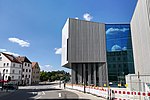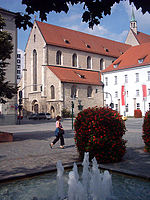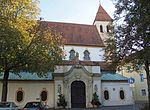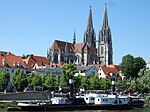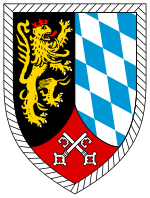Nibelungen Bridge (Regensburg)
Bridges completed in 2004Buildings and structures in RegensburgRoad bridges in Germany

The Nibelungen Bridge (German: Nibelungenbrücke) is a dual road bridge with two sections spanning both arms of the Danube at kilometre mark 2378.39 in Regensburg, Germany. The current bridge, the third on the site, was erected in 2001–04 to replace a bridge erected in 1950 which was no longer adequate for traffic demands, and which had replaced a bridge built in 1938 and destroyed in World War II. Carrying an average of 42,000 vehicles a day, it is one of the most important bridges in the Regensburg area.
Excerpt from the Wikipedia article Nibelungen Bridge (Regensburg) (License: CC BY-SA 3.0, Authors, Images).Nibelungen Bridge (Regensburg)
Nibelungenbrücke, Regensburg Weichs
Geographical coordinates (GPS) Address Nearby Places Show on map
Geographical coordinates (GPS)
| Latitude | Longitude |
|---|---|
| N 49.021388888889 ° | E 12.113055555556 ° |
Address
Nibelungenbrücke
93059 Regensburg, Weichs
Bavaria, Germany
Open on Google Maps
